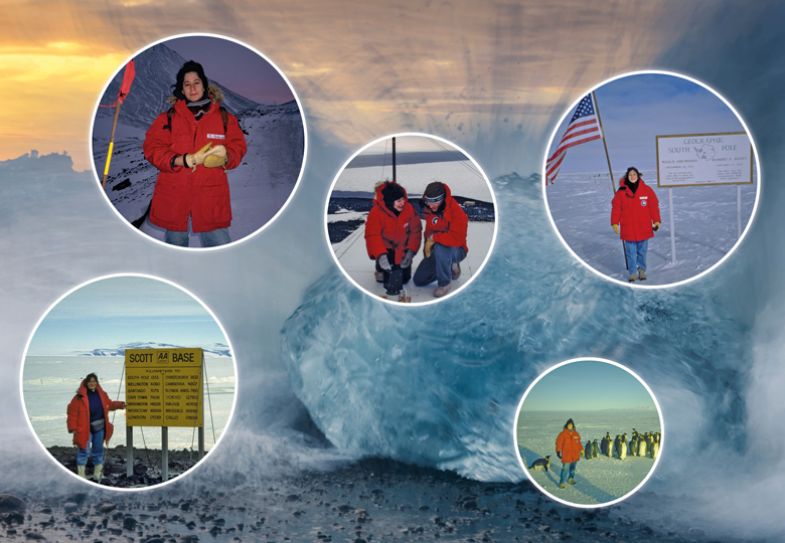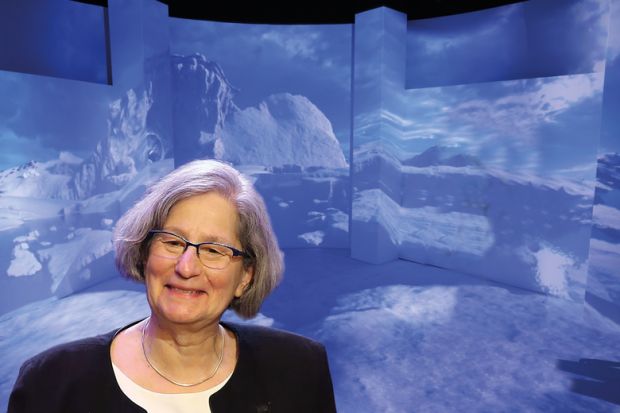At a time of widespread “eco-catastrophism”, says Susan Solomon, it is all too easy to “just wallow in our misery and how terrible everything is...But ‘all is lost’ is exactly the opposite of where we need to be.”
Now based at the Massachusetts Institute of Technology, Solomon has spent four decades researching, teaching and communicating climate science while also leading seemingly endless international environmental negotiations. From 2002 to 2008, she served as co-chair of the United Nations’ Intergovernmental Panel on Climate Change (IPCC) – a role that saw her picked out by Time magazine in 2008 as one of the 100 most influential people in the world.
While she admits that the finding of her most-cited paper – that carbon dioxide emitted today will still be around in the atmosphere in 1,000 years’ time – “kind of makes me sad”, Solomon outlines her “hope for the planet” in her new book, Solvable: How We Healed the Earth, and How We Can Do It Again (University of Chicago Press).
The source of her optimism can perhaps be traced to a “great scientific adventure” at the start of her career. In 1985, the British Antarctic Survey shocked the world by revealing that an unexpected hole had formed in the ozone layer above its station. It was clear that further research was needed.
Although Solomon describes herself in her book as an “ardent protector of the planet”, she was initially fascinated, she tells Times Higher Education, by the sheer intellectual challenge of using computer models to study the stratosphere, which she describes as “a beautiful example of chemical kinetics in action”. When the idea of an expedition to Antarctica came up, the person who had built the essential instrumentation had died and another expert was unavailable, so she “raised [her] hand and said, ‘I’ll go: I can do it,’ and everybody laughed. I can still remember the laughter in the room, but I didn’t care. I was in a situation where I thought I was the best person to do it.”
So, in 1986, at the age of 30, Solomon became the lead project scientist (and the only woman) in a team of 16 who spent two months in Antarctica. Her book describes arriving in a strange new world of “diffuse blue and purple twilight” and gathering data “while standing out on a rooftop in winds of 40 miles an hour and air temperatures of -40ºC” – and almost getting swept away when she had to rescue a valuable mirror system during a storm. Yet her research allowed her to test a range of explanations for the hole in the ozone layer and confirm her preferred theory: that the blame lay with the chlorofluorocarbon chemicals (CFCs) routinely used at the time in deodorants, hairsprays and refrigerators.
The expedition also alerted Solomon to the pressures that scientists working in policy-sensitive areas are inevitably subjected to.
“I had never had interactions with the media or Congress or any of that stuff before,” she explains. “So it was sort of a baptism by fire. All of a sudden, you’re doing science in a fishbowl and everybody’s wanting to call you up and get the inside story before you can actually publish your work and I wasn’t having any of that. I knew that was not the way to move good science forward.”
In the event, Solomon’s work provided crucial support for the 1987 Montreal Protocol on phasing out the production and consumption of ozone-depleting substances. The protocol is still the only UN treaty ever to have been signed by every single member nation, and Solomon’s book describes it as “the world’s greatest international environmental success story”.
To complete the circle, it was also one of Solomon’s papers, published in Science in 2016, “that is widely acknowledged as the first to show that the Antarctic ozone hole is starting to show signs of healing”, she says.

Solvable starts with this powerful first-hand example of achieving concrete change. It then turns to four other environmental success stories – addressing the hazards caused by smog, lead, pesticides and greenhouse gases – before drawing out the lessons for today’s efforts to combat climate change.
“This is stuff that young people particularly find quite amazing and surprising,” Solomon claims. “They just don’t know that we’ve ever succeeded in solving major problems – and why should they? They haven’t been exposed to it. Even older people need to be reminded, and then they say, ‘Oh yeah, that’s true. We did do that.’”
By taking the long view, Solomon is able to make a number of salient points. In the US, important bipartisan environmental protections have been put in place even under presidents committed to deregulation such as Ronald Reagan and during the exceptionally fractious Trump and post-Trump eras. It has also proved possible to overcome the resistance of powerful interested parties such as the vast automobile, farming and pesticide industries.
Public pressure, sometimes from surprising sources, has been crucial. Solvable describes how in 1957, when her daughter had a severe asthma attack, a woman called Marge Levee brought together “a group of equally enraged, equally well-to-do LA moms to form Stamp Out Smog (SOS)”. It also pays tribute to the Young Lords, a Puerto Rican former street gang which, in the era of civil rights, engaged in high-profile protests about the high levels of lead poisoning found among those dwelling in New York tenements, who were mainly families of colour or recent immigrants.
The public tends to get involved in campaigning against an environmental threat, according to Solomon, through a conjunction of what she calls “the three Ps”. The threat needs to feel personal and perceptible, and there need to be practical alternatives. As well as the dramatic sudden appearance of a hole in the ozone layer, people have also been energised by research showing the ongoing residues of the insecticide DDT could be found in mothers’ milk, and by the bleak message of Rachel Carson’s 1962 book, Silent Spring, that the birds are dying.
In some cases, public action can make a direct impact. Concerns about CFCs convinced many American consumers to abandon hairsprays and spray deodorants. Since these then made up about 75 per cent of the market for such chemicals, this in itself acted as a form of what Solomon calls “technology steering”, forcing manufacturers to accept that there was no future for “business as usual” and that they had to develop more environmentally friendly alternatives. Yet this is an unusual example of where something as cheap and easy as switching from a spray to a stick deodorant could make a real difference. More generally, explicit regulation or legislation is required to send a clear message to manufacturers that they need to change their ways, Solomon says.
Lawsuits and congressional hearings often pit different experts against each other, which can give manufacturers and other interested parties an opportunity to use eloquent mavericks to cast doubt on the scientific consensus. Far more effective, as Solomon sees it, is the formal process of scientific assessment, pioneered in the lead-up to the Montreal Protocol, which brings together a diverse team of specialists to summarise the current state of knowledge, with full supporting evidence. Solomon is one of only two people who have been involved with every assessment since 1986.
Campus resources on the Sustainable Development Goals
“Every UN process has an assessment mechanism, because otherwise one government comes in and says, ‘Our scientists say this’, and another government comes in and says, ‘Our scientists say that’, so there’s no way to get them to agree on a baseline of information, of actual fact, to the best extent that science can establish it,” Solomon explains. Negotiators “love” to be able to draw on such an accurate fact base "because that’s the only way they’re ever going to make any progress. Even the ones who want to impede progress actually love [scientific assessments] because they know [the assessment] might be a mechanism for doing that too.”
Solvable ends with an amusing vignette. In 2007, Solomon co-chaired the official plenary that approved the IPCC Fourth Scientific Assessment and, after six years’ work, representatives of 113 countries were debating every single word of the draft summary for policymakers. When the proposed headline statement, “warming is unequivocal”, was projected on to the screen, delegates from Switzerland and Colombia raised doubts about whether this could be effectively translated into French and Spanish. Fortunately, their French and Spanish counterparts immediately intervened to say that this was nonsense.
It is safe to say that not all disputes about tackling climate change can be tackled so easily, however. Solomon admits that “one of the ways in which climate change is cursed, relative to other issues, is that the type of phenomena that it produces are known phenomena, a hurricane or a major rainstorm or a forest fire. Those are frightening things, but they’re familiar things.” It is always harder to get people engaged and enraged by the intensification of familiar things than by disturbing new phenomena such as birds dropping out of the trees or a hole opening up in the ozone layer.
So why does Solomon remain optimistic that we can take the necessary action?
Today, she replies, “the climate has gotten so hot it’s become personal and perceptible” – in her own case, when she witnessed terrifying fires near the house that she and her husband had built in the Colorado Rockies. Others have seen with their own eyes the glaciers retreating in the Alps or the Andes. As a result, “The public doesn’t need to hear a lot more to convince them that there is a problem.”
Attacks on scientists, though often unpleasant, now implicitly concede the reality of climate change and fall back on the next line of defence for the fossil fuel industry: that there are no practical alternative sources of energy.
“I don’t think the scientific community should pay much attention to irrational claims, such as ‘You’re all in it for the money’ or ‘You’re all activists’ or something like that,” reflects Solomon. “Those things are so silly that you simply have to brush them off. You don’t let that kind of criticism stop you and you take pride in the fact that the attacks on the science itself have faded into the background. Now it’s all about attacking the technologies or the idea that a carbon tax is useful and stuff like that. That’s OK, we’ll fight that battle now.”
Here, too, Solomon believes that we are making real progress. Almost everywhere, her book reports, “it’s now cheaper to build and operate a renewable-energy power plant than one using coal, oil, or even gas. These are the stunning new messages of hundreds of experts and the world’s governments, who agreed on them for the first time in the 2022 report from the Intergovernmental Panel on Climate Change.”
None of this amounts to a detailed blueprint for change and there are clearly difficult times ahead. But Solomon hopes a new generation can embrace the complex remaining challenges with the kind of passion that took her to Antarctica in the 1980s.
“We are in a world bursting with change,” she points out, “so it’s a perfect time to be a climate scientist and study all those things.
“Every two or three years, something new will pop up and people will say: ‘Hey, we don’t understand this.’ Pick a topic which actually matters for the planet, and find a way to research it. It’s going to be a wild, exciting ride and the world needs you to do it.”
Register to continue
Why register?
- Registration is free and only takes a moment
- Once registered, you can read 3 articles a month
- Sign up for our newsletter
Subscribe
Or subscribe for unlimited access to:
- Unlimited access to news, views, insights & reviews
- Digital editions
- Digital access to THE’s university and college rankings analysis
Already registered or a current subscriber? Login








